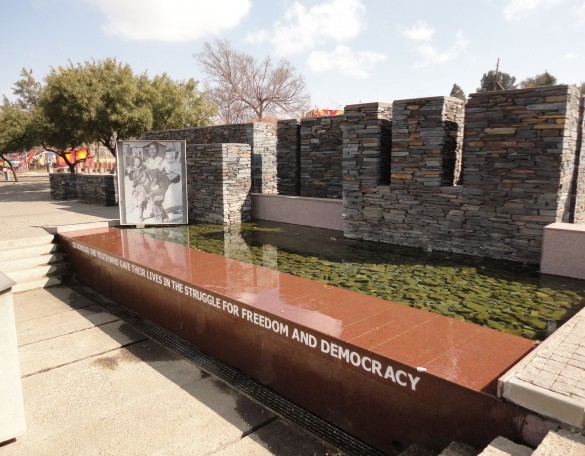When I traveled to South Africa in June just before the World Cup was about to begin, this being my first time there, I had a list of things to tackle including climbing Cape Town’s Table Mountain, hiking in the Drakensberg mountains, going on a Kruger safari, going to the Apartheid Museum in Johannesburg, and of course, enjoying the World Cup up close. Visiting a township was right near the top of this list.
The first time was outside of Cape Town, when we headed into what seemed like an entirely different world but was only a 20-minute drive from the city- the sprawling townships that were built to contain blacks and Coloureds during apartheid and keep them away from Cape Town proper. We drove by what seemed like some decent houses before passing wooden shacks and outhouses; a pattern that would be repeated during the trip. Finally we got out at a housing complex, walked into a sparse apartment and then a nearby hostel where rooms held several families sleeping on one bed each. We visited a kindergarten where we were “mobbed” by little tykes who urged us to take their pictures and lift them up.
Visiting Soweto a few weeks later, I walked through the place where black students were gunned down by police 34 years ago for protesting the enforced teaching of Afrikaans, but which now boasted a fine museum and neat brick houses, and down a street where Nelson Mandela and Desmond Tutu lived. What had been a key battleground in the struggle against apartheid was now a symbol of optimism and a proud heritage. Both times, I came away feeling illuminated, heartened that I had directly encountered, if only a little bit of, the less glamourous but vital aspect of this fascinating nation.
If all this sounds like a good travel experience, then you aren’t the only one. Taking a tour of slums and townships used to be unheard of but in recent years it has become an essential tourist activity. The idea behind people visiting these communities isn’t difficult to understand. Tourism supposedly benefits the communities when tour operators help support schools and art centers while tourists get a better understanding of the locals’ lives. However, “slum tourism” has also been heavily criticized, especially for being voyeuristic and not bringing significant benefits to locals.


Direct interaction goes a long way to promote mutual appreciation and avoid having locals be seen and pitied as disadvantaged people, which Odebe particularly criticized in his Times piece. Slum tours have become more engaging than voyeuristic, as travelers get to visit schools and businesses, talk to residents, attend church services or even have a drink in a neighborhood bar. My Lesotho outing to the village had us being accompanied on a hike by village kids, then a football game with some older kids, and finally a bout of pineapple beer at a home “brewery.” I have no way of knowing how the locals really felt, but the ones we met didn’t seem like they resented our presence.
Sometimes tourists are spurred on to further action, whether it is to donate to organizations or even volunteer later on. It’s even caused people to give up their jobs and go right back to the country to start their own organization, like former film studio executive Scott Neeson. On a vacation in Cambodia, Neeson was so moved after visiting a poor neighborhood situated by a massive garbage dump, that after going back to the US, he left his job and returned to form Cambodia Children’s Fund. His organization runs programs that provide education, shelter, and health care for over 700 poor children.
Of course, most visitors won’t do something so drastic and selfless, but this is one of many instances where people have been inspired to do something after having seen poverty up close.
That tours should be respectful of the communities and not be run as if it’s a safari should be a given. Eric Weiner, who has written on township tourism for the NY Times and Worldhum, stresses several guidelines that tours should follow. These include only going in small groups, not taking photos and that operators should contribute significantly to local projects; all of which make a lot of sense.
In the Cape Town townships, our guide assured us taking pictures was alright, unless it was of an adult. In that case, ask for permission and be respectful, he said. He also told us not to give sweets or money to the kids because this would make them develop the habit of begging tourists for things. As it was, the kids who approached us didn’t ask for anything.
There are different kinds of tours that offer different experiences. In South Africa, you can even stay overnight in townships such as Soweto in backpackers. There are standard tours that take you into townships to schools, homes, and even neighborhood bars (shebeens). Meanwhile, you can go on walking tours through the favelas of Rio de Janeiro or the massive slums of Mumbai.
In the end, I would say that “slumdog tourism,” the title of the Times article, is not entirely beneficial but neither is it entirely detrimental. No one should feel guilty if they want to visit a slum or township, but people should just go in the right frame of mind. Don’t treat it as a freak show and do respect the locals. And if you should ever come across anybody giving birth, don’t stop to watch and snap photos.
Hilton Yip is a writer and copy editor based in Taiwan. He blogs at hcyip.wordpress.com.